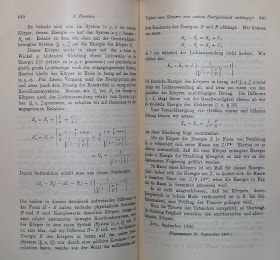 In 1905, during his now famous stint in the patent office, Albert Einstein published four articles in the scientific journal Annalen der Physik. This series of articles is often referred to as the Annus Mirabilis (extraordinary or miracle year) papers - reflecting their enormous impact on several key areas of modern physics.
In 1905, during his now famous stint in the patent office, Albert Einstein published four articles in the scientific journal Annalen der Physik. This series of articles is often referred to as the Annus Mirabilis (extraordinary or miracle year) papers - reflecting their enormous impact on several key areas of modern physics.The first article to be published was Über einen die Erzeugung und Verwandlung des Lichtes betreffenden heuristischen Gesichtspunk (June 9, 1905). This paper discussed the photoelectric effect (electrons can be ejected from a material if a sufficiently energetic beam is focused on the material) and demonstrated how observations of the phenomena could be explained by postulating that light is composed of discrete packets or quanta whose energy is determined by the frequency of the ray. Einstein ultimately received a Nobel Prize for this work.
The second article dealt with Brownian Motion - the movement of particles suspended in a fluid medium whose motive force is imparted by bombardment of the atoms of the fluid itself. Entitled Über die von der molekularkinetischen Theorie der Wärme geforderte Bewegung von in ruhenden Flüssigkeiten suspendierten Teilchen (July 18, 1905) this paper strongly supported the idea that the atom was a real entity and also lent support to the field of statistical mechanics.
The third article discussed special relativity. Zur Elektrodynamik bewegter Körper (September 26, 1905) demonstrated that Maxwell's equations for electricity and magnetism and the laws of mechanics could be reconciled at speeds approaching that of light, which was a fixed constant and so the same for all frames of reference.
The final paper of the "miracle year" was titled Ist die Trägheit eines Körpers von seinem Energieinhalt abhängig? (November 21, 1905). In this article Einstein presented one of the most famous equations of all time: E=mc2 (energy can be equated to the mass of an object times the square of the speed of light). This energy is known as rest energy and is distinct from an object's kinetic and potential energies.
To see all the original publications ask for Rare Book QC1 .A6133 v.322 no.6 (photoelectric effect), Rare Book QC1 .A6133 v.322 no.8 (brownian motion), Rare Book QC1 .A6133 v.322 no.10 (special relativity) and Rare Book QC1 .A6133 v.323 no.13 (mass energy equivalence).

No comments:
Post a Comment